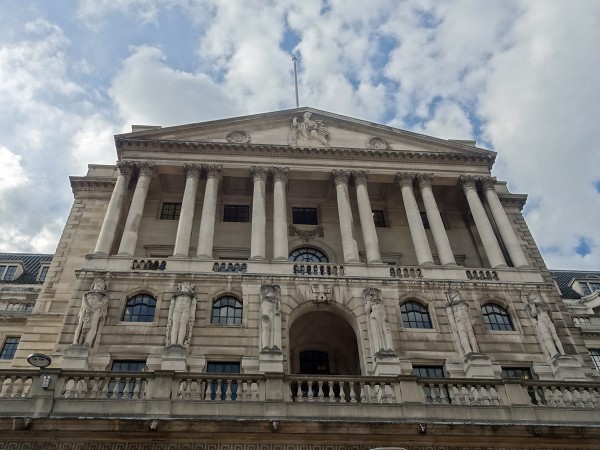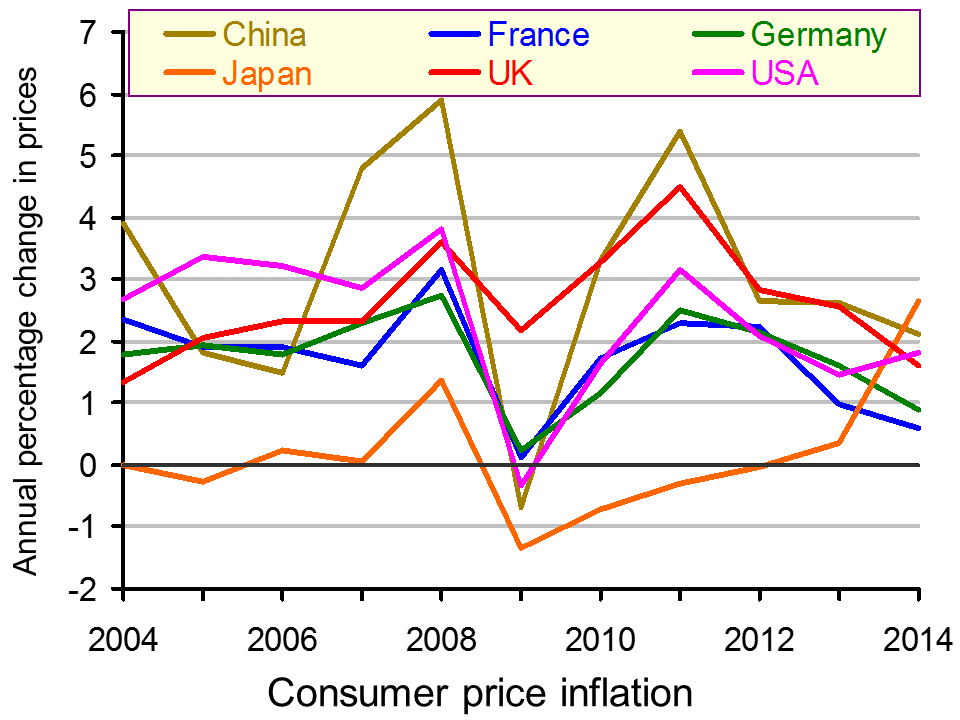 The articles linked below look at the dangers of deflation and policies of central banks to counter it.
The articles linked below look at the dangers of deflation and policies of central banks to counter it.
Deflation in economics has three meanings. The first is falling prices: i.e. negative inflation. The second, more traditional meaning, is a fall in real aggregate demand, resulting in lower output, higher unemployment and lower inflation – and quite possibly an actual fall in the price level. These first two definitions describe what is generally seen as an undesirable situation. The third is a slowing down in the growth of real aggregate demand, perhaps as a result of a deliberate act of fiscal and/or monetary policy. This third meaning could describe a desirable situation, where unsustainable growth is reduced and inflation is reduced from an above-target level.
Here we focus on the first definition. The first two articles look at the dangers of a fall in the price level. The chart below shows falling inflation, although not actually deflation, in China, France, Germany and the UK (click here for a PowerPoint). Several European countries, however, are experiencing actual deflation. These include: Greece, Spain, Hungary, Poland and Sweden. Inflation in the eurozone for 2014 is expected to be a mere 0.5%.
The most obvious danger of deflation (or expected deflation) is that people will delay spending on durable goods, such as cars, furniture and equipment, hoping to buy the items cheaper later.  The result could be a fall in aggregate demand and a fall in output and employment.
The result could be a fall in aggregate demand and a fall in output and employment.
For retailers, this is all spelling Christmas doom. Already the runup to the most crucial time of the year for shops is being characterised by a game of chicken. Shoppers are wondering how long they can leave their festive buying in the hope of late bargains.
Interest rates may be low, but for people with debts, this is being offset by the fact that inflation is no longer reducing the real value of that debt. For people with credit card debt, personal loans and most mortgages, the interest rate they pay is significantly above the rate of inflation. In other words, the real interest rate on their debt is still significantly positive. This may well discourage people from borrowing and spending, further dampening aggregate demand. And, with a Bank Rate of just 0.5%, there is virtually no scope for lowering the official interest rate further.
At least in the UK, economic growth is now positive – for the time being at any rate. The danger is becoming more serious, however, in many eurozone countries, which are already back in recession or close to being so. The ECB, despite its tentative steps to ease credit conditions, it moving closer to the day when it announces full-blown quantitative easing and buys sovereign bonds of eurozone countries. The Bank of Japan has already announced that it is stepping up it QE programme – a vital ingredient in getting Abenomics back on track and pulling Japan out of its latest recession.
In the USA, by contrast, there is little danger of deflation, as the US economy continues to grow strongly. The downside of this, has been a large rise in consumer debt (but not mortgages) – the ingredients of a possible future bubble and even a new financial crisis.
Forget what central bankers say: deflation is the real monster The Observer, Katie Allen (23/11/14)
Why Deflation Is Such A Big Worry For Europe NPR, Jim Zarroli (31/10/14)
Exclusive: China ready to cut rates again on fears of deflation – sources Reuters, Kevin Yao (23/11/14)
Central Banks in New Push to Prime Pump Wall Street Journal Jon Hilsenrath, Brian Blackstone and Lingling Wei (21/11/14)
Are Central Banks Panicking? Seeking Alpha, Leo Kolivakis (21/11/14)
Questions
- What are (a) the desirable and (b) the undesirable consequences of deflation? Does the answer depend on how deflation is defined?
- What is meant by a ‘deflationary gap’? In what sense is ‘deflationary’ being used in this term?
- Why have oil prices been falling? How desirable are these falls for the global economy?
- Is there an optimal rate of inflation? If so, how would this rate be determined?
- The chart shows that inflation in Japan is likely to have risen in 2014. This in large part is the result to a rise in the sales tax earlier this year. If there is no further rise in the sales tax, which there will probably not be if Mr Abe’s party wins the recently called election, what is likely to be the effect of the 2014 tax rise on inflation in 2015?
- If the Bank Rate is below the rate of inflation, why are people facing a positive real rate of interest? Does this apply equally to borrowers and savers?
- In what sense is there a cultural revolution at the Bank of England?
